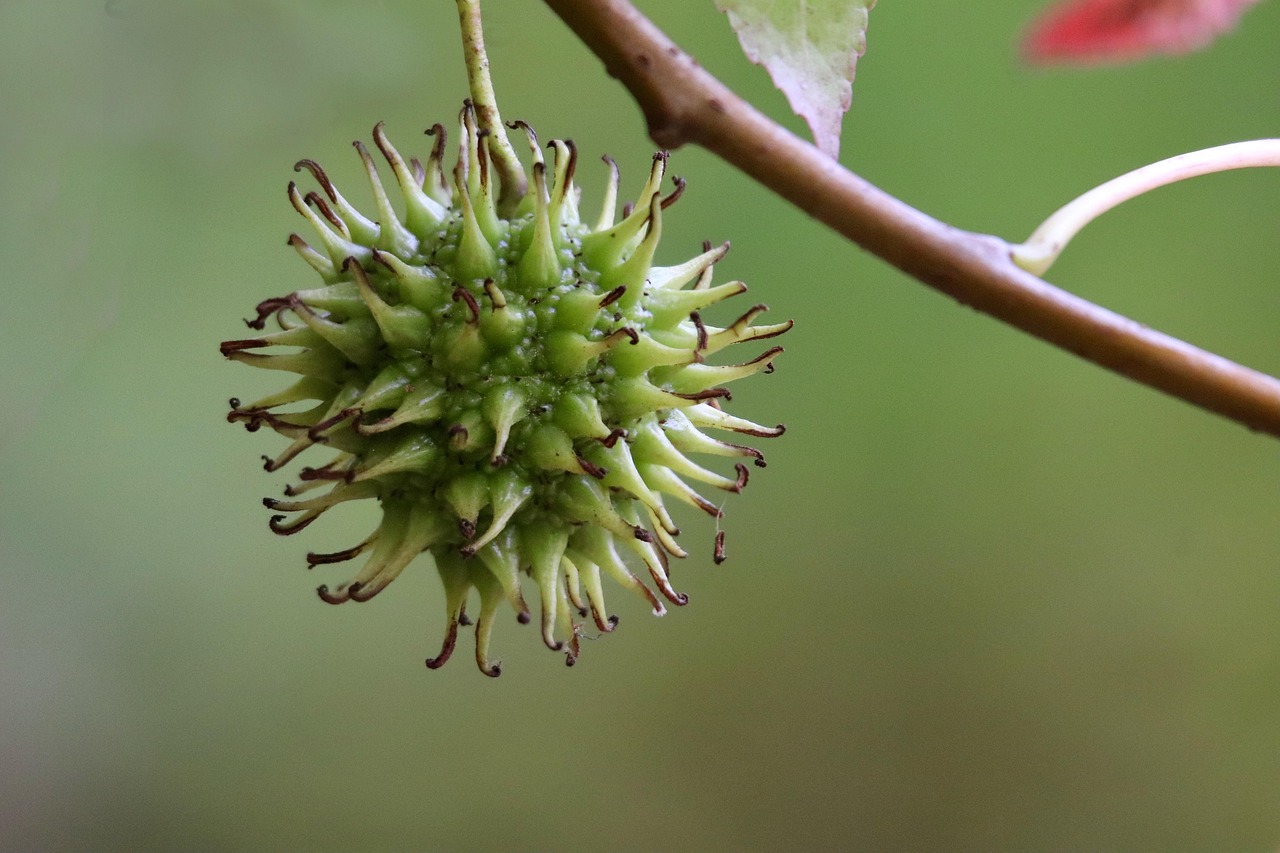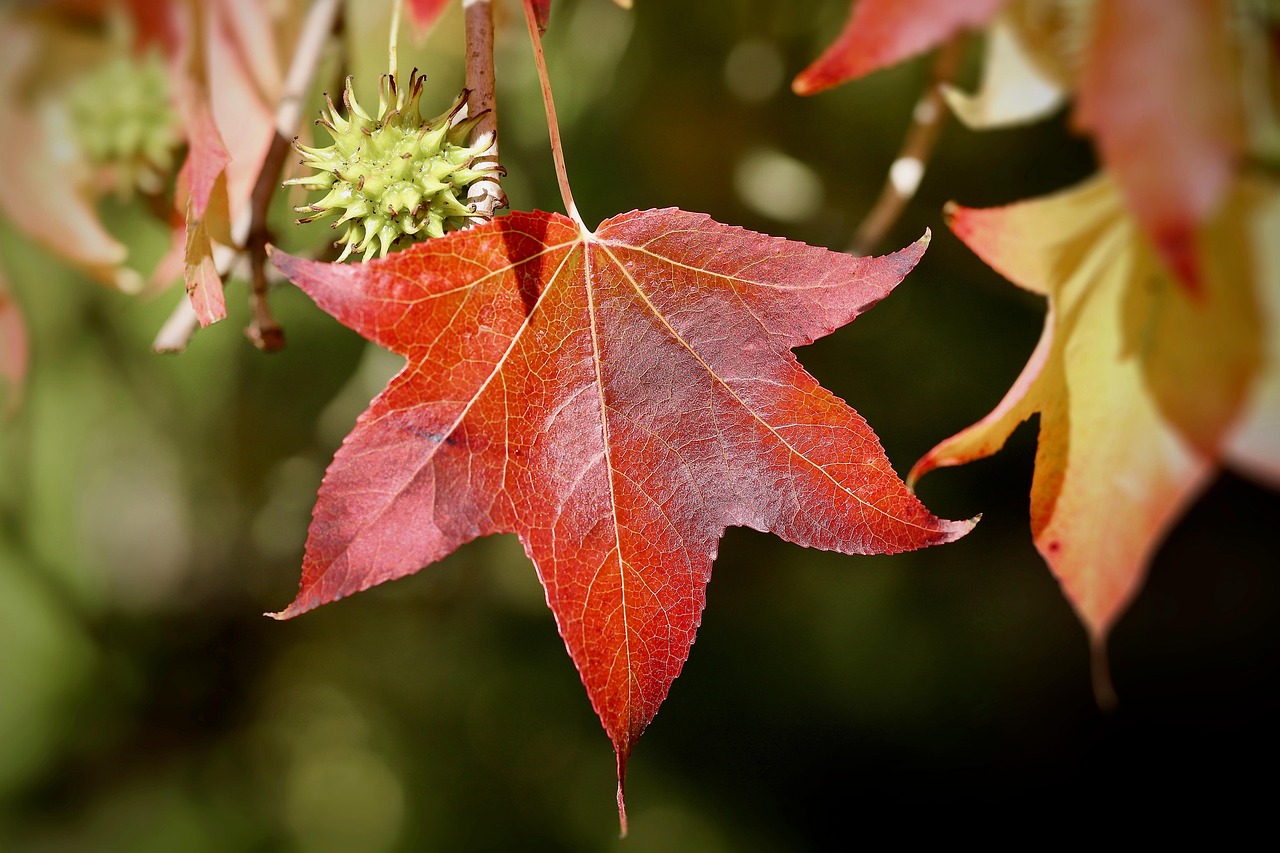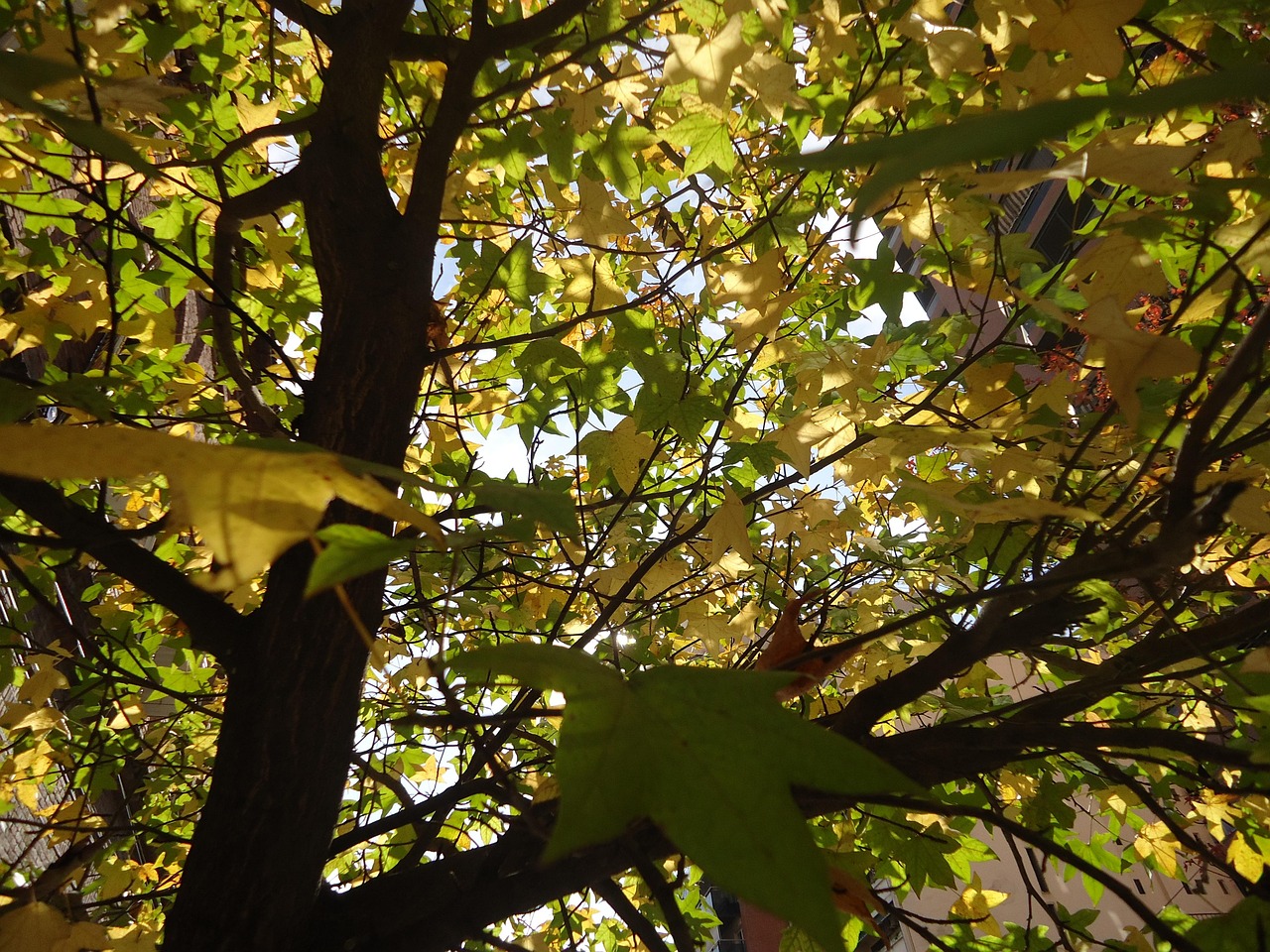The Sweetgum tree, known scientifically as Liquidambar styraciflua, is primarily found in the southeastern United States. Its natural habitat includes regions with moist, well-drained soils, especially near rivers and swamps, extending from Texas to Florida and up to parts of Maryland and Virginia.
Understanding the Sweetgum Tree

The Sweetgum tree is a deciduous tree that belongs to the Altingiaceae family. This species is known for its star-shaped leaves and spiky fruit, which can be quite distinctive. The tree can grow to heights of 60 to 100 feet, making it a prominent feature in its natural environment. Sweetgum trees thrive in a variety of soil types but prefer locations that offer ample sunlight and moisture.
These trees are not just visually appealing; they play an essential role in their ecosystems. Their broad canopy provides shade for many undergrowth plants, while the fallen leaves enrich the soil as they decompose. Additionally, the tree’s unique fruit serves as a food source for various wildlife species.
Geographic Distribution
The Sweetgum tree is native to a specific range in North America. It is predominantly found in the following states:
- Texas
- Louisiana
- Mississippi
- Alabama
- Georgia
- Florida
- South Carolina
- North Carolina
- Virginia
- Maryland
This tree prefers warm climates and is often seen in hardwood forests, where it grows alongside other native species. In addition to its native range, Sweetgum trees have been introduced to various regions outside their natural habitat due to their ornamental value.
Typical Habitat Conditions
Sweetgum trees thrive in areas with certain environmental characteristics. They favor:
- Soil: Moist, well-drained soils rich in organic matter.
- Sunlight: Full sun to partial shade conditions.
- Moisture: Proximity to water sources such as rivers, swamps, or wetlands.
This adaptability allows them to grow in diverse landscapes, from urban areas to rural settings. Their presence is often noted in parks and gardens where they are valued for their aesthetic appeal.
Identification Features
The Sweetgum tree can be identified by several key features:
- Leaves: Star-shaped with five pointed lobes, turning vibrant colors in fall.
- Bark: Reddish-brown with a corky texture that becomes furrowed with age.
- Fruit: Spiky, round seed balls that are often seen hanging from the branches.
These characteristics make the Sweetgum tree easily recognizable throughout its growing regions. Observing these features can help anyone identify this unique tree in its natural habitat.
Ecological Importance
The ecological role of the Sweetgum tree is significant. It helps stabilize soil and prevent erosion, particularly in riparian zones. Additionally, it provides habitat for various bird and insect species. The tree also acts as a natural air purifier by absorbing carbon dioxide and releasing oxygen during photosynthesis.
The Sweetgum tree’s ability to adapt to different soil and moisture conditions contributes to its widespread distribution in the southeastern U.S. Understanding where this tree commonly grows can help in conservation efforts and landscape planning.
Growth and Maintenance of the Sweetgum Tree
The Sweetgum tree is not only notable for its distinctive features but also for its growth habits and maintenance needs. Understanding these aspects is crucial for anyone looking to plant or care for this tree in their landscape.
Growth Rate and Lifespan
The Sweetgum tree typically grows at a moderate rate, achieving heights of up to 100 feet over several decades. Under optimal conditions, it can grow about 12 to 24 inches per year. Its lifespan can extend to 30-50 years, although some trees may live longer under ideal circumstances.
Soil and Water Requirements
For optimal growth, the Sweetgum tree prefers:
- Soil Type: Well-drained, loamy soils enriched with organic material.
- Moisture: Regular watering is important, especially during dry spells. However, the tree should not be waterlogged.
While the tree can tolerate a range of soil types, it thrives best in slightly acidic conditions. Amending the soil with compost can enhance its nutrient profile and support healthy growth.
Sunlight Needs
The Sweetgum tree flourishes in full sunlight. It requires at least six hours of direct sunlight each day to maintain robust health and vibrant foliage. In shaded areas, the tree may become leggy as it reaches for light, potentially compromising its overall structure.
Pruning and Care
Regular pruning is essential for maintaining the shape and health of the Sweetgum tree. Consider the following guidelines:
- Timing: The best time to prune is during late winter or early spring before new growth begins.
- Technique: Remove any dead, damaged, or crossing branches to improve airflow and reduce disease risk.
- Shape: Aim for a balanced crown to ensure even growth and aesthetic appeal.
Proper pruning helps prevent issues related to overcrowding and enhances the overall beauty of the tree. It also encourages healthy growth and fruit production.
Pests and Diseases
The Sweetgum tree is relatively resilient but can be susceptible to certain pests and diseases. Being aware of these threats can aid in timely management and treatment.
Common Pests
Some pests that may affect Sweetgum trees include:
- Aphids: These small insects can weaken the tree by sucking sap from leaves.
- Scale Insects: Scale can cause leaf drop and overall decline in health.
- Caterpillars: Various caterpillar species may feed on Sweetgum leaves, leading to defoliation.
Regular monitoring and natural predators can help manage these pests effectively. In severe cases, insecticidal treatments may be necessary.
Diseases to Watch For
The Sweetgum tree may also face diseases such as:
- Leaf Spot: Fungal infections can lead to unsightly spots on leaves, which may eventually fall off.
- Canker: This disease can cause branch dieback and should be treated promptly to prevent further spread.
- Root Rot: Overwatering or poor drainage can lead to root rot, which is detrimental to the tree’s health.
Maintaining proper cultural practices, such as ensuring well-drained soil and adequate air circulation, can minimize the risk of these diseases.
Uses of the Sweetgum Tree
The Sweetgum tree is valued for various uses beyond its ecological contributions. Its wood is highly regarded for several applications:
- Lumber: The wood is durable and often used in furniture-making and cabinetry.
- Pulpwood: It can be processed into paper products.
- Ornamental Uses: Due to its attractive foliage, the Sweetgum tree is commonly planted in parks and gardens.
Additionally, its beautiful fall colors make it a popular choice for landscaping. The range of its uses highlights the importance of this tree in both ecological and human contexts.

2>Cultural Significance of the Sweetgum Tree
The Sweetgum tree holds cultural significance in various communities across the southeastern United States. Its presence is often associated with historical practices, local traditions, and even folklore.
Historical Uses
Historically, Indigenous peoples utilized the Sweetgum tree for multiple purposes:
- Medicine: The resin from the tree was used in traditional medicine for its healing properties.
- Crafts: The wood was fashioned into tools and crafts due to its strength and durability.
- Fuel: Dried Sweetgum wood served as an effective fuel source for cooking and heating.
These historical uses illustrate how the Sweetgum tree has been integral to the lives of those who lived in proximity to it, reflecting a deep connection to nature.
Folklore and Symbolism
The Sweetgum tree also features in local folklore and symbolism. In some cultures, it is seen as a symbol of resilience and strength due to its ability to thrive in various environments. The tree’s vibrant fall colors are often celebrated in local festivals, drawing attention to its beauty and importance.
Sweetgum Tree in Landscaping

>Due to its aesthetic appeal and practical uses, the Sweetgum tree is a popular choice for landscaping. Its unique features can enhance the beauty of residential and commercial properties.
Aesthetic Appeal
The Sweetgum tree offers several aesthetic benefits:
- Fall Foliage: The leaves turn brilliant shades of yellow, orange, and red in the autumn, creating a stunning visual display.
- Unique Shape: The star-shaped leaves and spiky fruit add texture and interest to gardens.
- Shade Provider: Its broad canopy offers ample shade, making it ideal for parks and backyard spaces.
These features make the Sweetgum tree an attractive addition to many landscapes, providing both beauty and functionality.
Considerations for Planting
When planting a Sweetgum tree, several factors should be considered to ensure its successful growth:
- Space Requirements: Given its potential height and spread, ensure there is enough space for the tree to grow without interference from buildings or other trees.
- Soil Preparation: Prior to planting, amend the soil with organic matter to enhance drainage and nutrient availability.
- Location: Choose a location that receives full sun to support optimal growth and leaf development.
Proper planning and preparation can lead to a thriving Sweetgum tree that enhances the landscape for years to come.
Environmental Impact of Planting Sweetgum Trees
The Sweetgum tree plays a significant role in environmental sustainability. Its contribution extends beyond aesthetics to include ecological benefits that support local wildlife and ecosystems.
Biodiversity Support
Planting Sweetgum trees can enhance biodiversity in several ways:
- Habitat Creation: The tree provides shelter and nesting sites for birds and small mammals.
- Food Source: The spiky fruit serves as a food source for various bird species, while the leaves provide nourishment for insects.
- Pollen Source: In spring, the flowers attract pollinators such as bees, contributing to overall ecosystem health.
This positive impact on biodiversity emphasizes the importance of incorporating Sweetgum trees into community landscaping and conservation efforts.
Carbon Sequestration
The Sweetgum tree also plays a role in combating climate change through carbon sequestration. As it grows, it absorbs carbon dioxide from the atmosphere, storing carbon in its biomass. This process helps reduce greenhouse gases and improve air quality.
The ability of the Sweetgum tree to thrive in various conditions makes it a valuable asset for urban forestry initiatives aimed at increasing green spaces and improving environmental health within cities.
Challenges and Considerations for Sweetgum Trees

>While Sweetgum trees offer many benefits, there are some challenges and considerations to keep in mind when planting and maintaining them. Awareness of these aspects can help ensure successful growth and integration into landscapes.
Seed Ball Dispersal
One of the unique characteristics of Sweetgum trees is their spiky seed balls, which can create a mess when they fall. These seed balls can be a nuisance in lawns and gardens due to their sharp edges. Here are some points to consider:
- Cleaning: Regular raking may be necessary to keep areas tidy.
- Location: Planting the tree away from high-traffic areas can help minimize discomfort caused by the seed balls.
- Ground Cover: Utilizing ground cover plants beneath the tree can help camouflage fallen seed balls and maintain aesthetic appeal.
Potential for Overcrowding
As Sweetgum trees mature, they can create dense canopies that may lead to overcrowding in smaller landscapes. This can result in competition for sunlight and nutrients among nearby plants. To manage this, consider the following:
- Spacing: Ensure adequate spacing between the Sweetgum and other trees or plants to allow for healthy growth.
- Pruning: Regular pruning can help maintain an open canopy and reduce competition.
- Diversity: Incorporate a variety of tree species in landscaping to promote biodiversity and reduce the risk of overcrowding.
Climate Adaptability
While the Sweetgum tree is native to the southeastern United States, it may not thrive in all climates. It prefers warm conditions and is not well-suited for areas with harsh winters. Consider regional climate conditions before planting:
- Hardiness Zones: Sweetgum trees thrive best in USDA hardiness zones 5 to 9.
- Temperature Sensitivity: Extreme cold or prolonged frost can damage young trees. Protection during harsh winters may be necessary in northern ranges.
Final Thoughts
The Sweetgum tree is a remarkable species that contributes significantly to its environment through its ecological benefits, aesthetic appeal, and cultural significance. Its adaptability allows it to thrive in various settings, making it a valuable addition to landscapes across the southeastern United States.
From providing habitat for wildlife to enhancing biodiversity, the Sweetgum tree plays a crucial role in promoting healthy ecosystems. Its vibrant fall colors add beauty to parks, gardens, and urban landscapes, while its sturdy wood serves practical purposes in construction and crafts.
However, potential challenges such as seed ball dispersal and climate sensitivity should be considered when incorporating Sweetgum trees into landscaping. By understanding these challenges and implementing thoughtful planning and maintenance practices, communities can enjoy the many benefits that this magnificent tree has to offer.
In conclusion, whether you are a homeowner looking to beautify your property or a conservationist aiming to enhance local ecosystems, the Sweetgum tree deserves consideration for its numerous advantages. Embracing this tree can lead to a more vibrant and sustainable environment for both people and wildlife alike.
